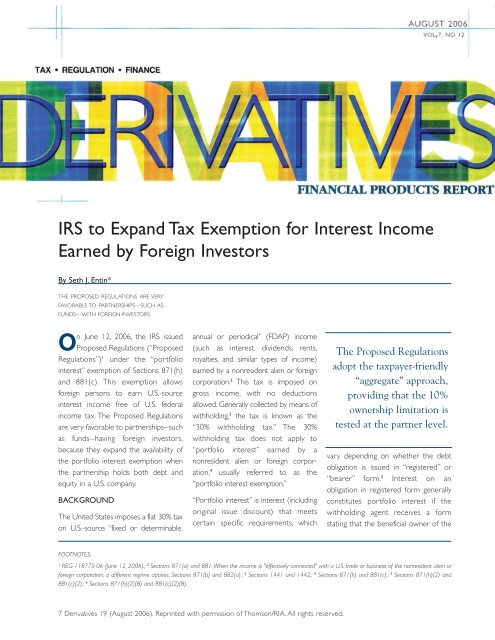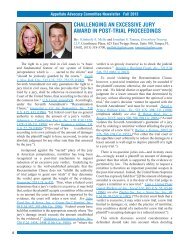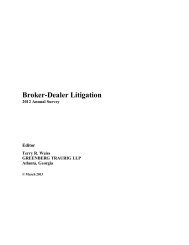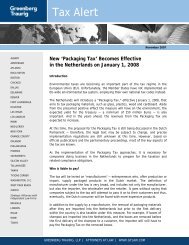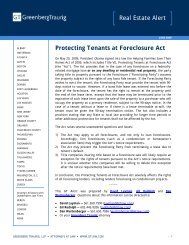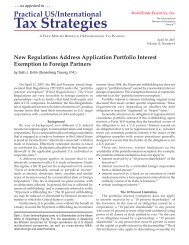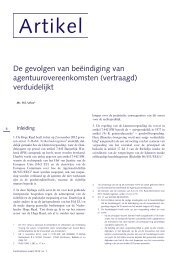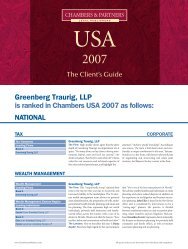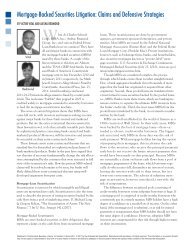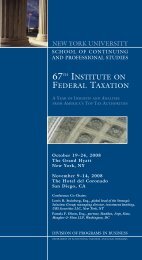IRS to Expand Tax Exemption for Interest Income Earned by Foreign ...
IRS to Expand Tax Exemption for Interest Income Earned by Foreign ...
IRS to Expand Tax Exemption for Interest Income Earned by Foreign ...
Create successful ePaper yourself
Turn your PDF publications into a flip-book with our unique Google optimized e-Paper software.
<strong>IRS</strong> <strong>to</strong> <strong>Expand</strong> <strong>Tax</strong> <strong>Exemption</strong> <strong>for</strong> <strong>Interest</strong> <strong>Income</strong><br />
<strong>Earned</strong> <strong>by</strong> <strong>Foreign</strong> Inves<strong>to</strong>rs<br />
By Seth J. Entin*<br />
THE PROPOSED REGULATIONS ARE VERY<br />
FAVORABLE TO PARTNERSHIPS—SUCH AS<br />
FUNDS—WITH FOREIGN INVESTORS.<br />
On June 12, 2006, the <strong>IRS</strong> issued<br />
Proposed Regulations (“Proposed<br />
Regulations”) 1 under the “portfolio<br />
interest” exemption of Sections 871(h)<br />
and 881(c). This exemption allows<br />
<strong>for</strong>eign persons <strong>to</strong> earn U.S.-source<br />
interest income free of U.S. federal<br />
income tax. The Proposed Regulations<br />
are very favorable <strong>to</strong> partnerships--such<br />
as funds--having <strong>for</strong>eign inves<strong>to</strong>rs,<br />
because they expand the availability of<br />
the portfolio interest exemption when<br />
the partnership holds both debt and<br />
equity in a U.S. company.<br />
BACKGROUND<br />
The United States imposes a flat 30% tax<br />
on U.S.-source “fixed or determinable,<br />
annual or periodical” (FDAP) income<br />
(such as interest, dividends, rents,<br />
royalties, and similar types of income)<br />
earned <strong>by</strong> a nonresident alien or <strong>for</strong>eign<br />
corporation. 2 This tax is imposed on<br />
gross income, with no deductions<br />
allowed. Generally collected <strong>by</strong> means of<br />
withholding, 3 the tax is known as the<br />
“30% withholding tax.” The 30%<br />
withholding tax does not apply <strong>to</strong><br />
“portfolio interest” earned <strong>by</strong> a<br />
nonresident alien or <strong>for</strong>eign corporation,<br />
4 usually referred <strong>to</strong> as the<br />
“portfolio interest exemption.”<br />
“Portfolio interest” is interest (including<br />
original issue discount) that meets<br />
certain specific requirements, which<br />
The Proposed Regulations<br />
adopt the taxpayer-friendly<br />
“aggregate” approach,<br />
providing that the 10%<br />
ownership limitation is<br />
tested at the partner level.<br />
vary depending on whether the debt<br />
obligation is issued in “registered” or<br />
“bearer” <strong>for</strong>m. 5 <strong>Interest</strong> on an<br />
obligation in registered <strong>for</strong>m generally<br />
constitutes portfolio interest if the<br />
withholding agent receives a <strong>for</strong>m<br />
stating that the beneficial owner of the<br />
FOOTNOTES:<br />
1<br />
REG-118775-06 (June 12, 2006).; 2 Sections 871(a) and 881.When the income is "effectively connected" with a U.S. trade or business of the nonresident alien or<br />
<strong>for</strong>eign corporation, a different regime applies. Sections 871(b) and 882(a).; 3 Sections 1441 and 1442.; 4 Sections 871(h) and 881(c).; 5 Sections 871(h)(2) and<br />
881(c)(2).; 6 Sections 871(h)(2)(B) and 881(c)(2)(B).<br />
7 Derivatives 19 (August 2006). Reprinted with permission of Thomson/RIA. All rights reserved.
obligation is not a U.S. person. 6 <strong>Interest</strong><br />
earned on an obligation not in<br />
registered <strong>for</strong>m (i.e., in bearer <strong>for</strong>m)<br />
can be portfolio interest if the issuer of<br />
the obligation complies with certain<br />
procedures generally designed <strong>to</strong><br />
ensure that the holder of the obligation<br />
is not a U.S. person. 7<br />
There are, however, certain limitations<br />
on the availability of the portfolio<br />
interest exemption. For example, it<br />
does not apply <strong>to</strong>:<br />
1. <strong>Interest</strong> received <strong>by</strong> a “10%<br />
shareholder” of the borrower<br />
(referred <strong>to</strong> herein as the “10%<br />
ownership limitation”). 8<br />
2. <strong>Interest</strong> received <strong>by</strong> a controlled<br />
<strong>for</strong>eign corporation from a related<br />
person. 9<br />
3. <strong>Interest</strong> received <strong>by</strong> a bank on an<br />
extension of credit made pursuant<br />
<strong>to</strong> a loan agreement entered in<strong>to</strong> in<br />
the ordinary course of its trade or<br />
business. 10<br />
4. Certain contingent interest. 11<br />
10% OWNERSHIP LIMITATION<br />
The portfolio interest exemption does<br />
not apply <strong>to</strong> interest received <strong>by</strong> a<br />
“10% shareholder” of the borrower. For<br />
an obligation issued <strong>by</strong> a corporation, a<br />
“10% shareholder” is any person who<br />
owns 10% or more of the <strong>to</strong>tal<br />
combined voting power of all classes of<br />
s<strong>to</strong>ck entitled <strong>to</strong> vote. 12 For an<br />
obligation issued <strong>by</strong> a partnership, a<br />
“10% shareholder” is any person that<br />
owns 10% or more of the capital or<br />
profits interest in the partnership. 13<br />
The Section 318 attribution rules apply<br />
in determining ownership <strong>for</strong> purposes<br />
of the 10% ownership limitation, with<br />
several important modifications. 1 4 One<br />
example, discussed below, is that a<br />
person owns an option <strong>to</strong> acquire<br />
s<strong>to</strong>ck and is treated as owning the<br />
s<strong>to</strong>ck under the Section 318 attribution<br />
rules. 1 5 The portfolio interest statute,<br />
however, modifies that general rule.<br />
This modification provides that ownership<br />
of an option <strong>to</strong> acquire s<strong>to</strong>ck is not<br />
treated as s<strong>to</strong>ck ownership in applying<br />
the attribution rules <strong>to</strong> determine<br />
whether s<strong>to</strong>ck ownership is attributed<br />
from a partnership <strong>to</strong> its partner, from<br />
a trust <strong>to</strong> its beneficiaries, or from a<br />
corporation <strong>to</strong> its shareholders (or vice<br />
versa). 16<br />
WHERE THE 10% OWNERSHIP<br />
LIMITATION IS TESTED<br />
Practitioners and commenta<strong>to</strong>rs have<br />
debated how the 10% ownership<br />
limitation should be tested if the holder<br />
of the debt is a partnership that has<br />
<strong>for</strong>eign members. The issue is whether<br />
the 10% ownership limitation is tested<br />
at the partnership level (“entity”<br />
approach) or at the partner level<br />
(“aggregate” approach).<br />
Under the entity approach, the<br />
determinative fac<strong>to</strong>r is whether the<br />
partnership itself owns a 10% or<br />
greater interest in the U.S. borrower. If<br />
it does, the interest paid <strong>by</strong> the U.S.<br />
borrower will not qualify <strong>for</strong> the<br />
portfolio interest exemption, regardless<br />
of the magnitude of the <strong>for</strong>eign<br />
partner’s interest in the partnership.<br />
On the other hand, if the 10%<br />
ownership limitation is tested at the<br />
partner level, the proportionate<br />
interest of each <strong>for</strong>eign partner in the<br />
borrower is looked at <strong>to</strong> determine<br />
whether the <strong>for</strong>eign partner qualifies<br />
<strong>for</strong> the portfolio interest exemption on<br />
the partner’s proportionate share of<br />
the interest income. 17<br />
Example. A partnership (U.S. or<br />
<strong>for</strong>eign) holds a debt instrument issued<br />
<strong>by</strong> a U.S. corporate borrower. The<br />
partnership also owns 20% of the<br />
borrower’s voting s<strong>to</strong>ck. Each of 100<br />
unrelated nonresident alien partners<br />
owns 1% of the partnership. If the 10%<br />
ownership limitation is tested at the<br />
partnership level, the interest paid <strong>by</strong><br />
the U.S. borrower will not qualify <strong>for</strong><br />
the portfolio interest exemption,<br />
because the partnership owns 20% of<br />
the corporation’s voting s<strong>to</strong>ck. On the<br />
other hand, if the 10% ownership<br />
limitation is tested at the partner level,<br />
the interest will qualify <strong>for</strong> the portfolio<br />
interest exemption, because none of<br />
the partners indirectly owns a 10% or<br />
greater interest in the U.S. borrower.<br />
Previously, the only indication of the<br />
<strong>IRS</strong>’ position was a 1994 field service<br />
advice (“1994 FSA”) that <strong>to</strong>ok the<br />
stance that the 10% ownership<br />
limitation is tested at the partner level,<br />
not at the partnership level. 18<br />
A field service advice, however, is not<br />
binding authority. There<strong>for</strong>e, practitioners<br />
have requested more <strong>for</strong>mal<br />
guidance from Treasury. 19<br />
FOOTNOTES:<br />
7<br />
Sections 871(h)(2)(A) and 881(c)(2)(A).; 8<br />
Sections 871(h)(3) and 881(c)(3)(B).; 9<br />
Section 881(c)(3)(C).;<br />
10<br />
Section 881(c)(3)(A).;<br />
11<br />
Sections 871(h)(4) and<br />
881(c)(4); 1 2 Section 871(h)(3)(B)(i).; 1 3 Section 871(h)(3)(B)(ii).; 1 4 Section 871(h)(3)(C).; 1 5 Section 318(a)(4).; 1 6 Section 871(h)(3)(C)(iii).; 1 7 See, e.g., Garlock, Federal<br />
<strong>Income</strong> <strong>Tax</strong>ation of Debt instruments (4th ed., 2000) sec. 17.04(C); Entin, "Partnerships and the Portfolio <strong>Interest</strong> <strong>Exemption</strong>," 100 <strong>Tax</strong> Notes 1171 (Sept. 1, 2003);<br />
Needham, "A Guide <strong>to</strong> <strong>Tax</strong> Planning <strong>for</strong> Private Equity Funds and Portfolio Investments (Part 1)," 99 <strong>Tax</strong> Notes 1215, 1239-40 (May 20, 2002); Staffaroni,<br />
"Partnerships: Aggregate v. Entity in U.S. International <strong>Tax</strong>ation," 49 <strong>Tax</strong> Law 55, 123 (1995); 1 8 1994 Westlaw 1866354; 1994 FSA LEXIS 430 (Feb. 2, 1994); 19<br />
ABA Section of <strong>Tax</strong>ation, "The Need <strong>for</strong> Guidance on the Portfolio <strong>Interest</strong> <strong>Exemption</strong>," 101 <strong>Tax</strong> Notes 701 (May 10, 2004).
Proposed Regulations. The Proposed<br />
Regulations adopt the taxpayer-friendly<br />
“aggregate” approach and provide that<br />
the 10% ownership limitation is tested<br />
at the partner level. There<strong>for</strong>e, in the<br />
above example, the interest would<br />
qualify <strong>for</strong> the portfolio interest<br />
exemption. 20<br />
If Treasury believes that the<br />
aggregate approach reflects the<br />
proper interpretation of the<br />
statute, that interpretation<br />
should control regardless of<br />
when the note is issued.<br />
Under the Proposed Regulations,<br />
accordingly, <strong>for</strong>eign partners in a<br />
partnership can earn their distributive<br />
share of the partnership’s interest<br />
income free of the 30% withholding tax<br />
even if the partnership holds 10% or<br />
more of the equity in the U.S.<br />
borrower, so long as the partners do<br />
not each own a 10% or greater direct<br />
or constructive equity interest in the<br />
U.S. borrower.<br />
The Preamble <strong>to</strong> the Proposed<br />
Regulations states that Treasury’s<br />
adoption of the aggregate approach<br />
reflects its view that a partnership may<br />
be treated either as an aggregate of its<br />
partners or as an entity separate from<br />
its partners, depending on which<br />
characterization is more appropriate <strong>to</strong><br />
carry out the purpose of the specific<br />
Code provision at issue. According <strong>to</strong><br />
the Preamble, the aggregate approach<br />
here is supported <strong>by</strong> the policy and<br />
structure of the portfolio interest<br />
statute. 21<br />
WHEN 10% OWNERSHIP<br />
LIMITATION IS TESTED<br />
The statute does not explicitly provide<br />
at what point in time the 10%<br />
ownership limitation is tested. Under the<br />
Proposed Regulations, it is tested with<br />
respect <strong>to</strong> a nonresident alien individual<br />
or <strong>for</strong>eign corporation that is a partner<br />
in the partnership when a withholding<br />
agent, absent any exceptions, would<br />
otherwise be required <strong>to</strong> withhold<br />
under Sections 1441 and 1442 with<br />
respect <strong>to</strong> the interest. 2 2 It is hoped that<br />
Treasury will eventually expand this<br />
guidance <strong>to</strong> all cases involving the 10%<br />
ownership limitation, not just partnership<br />
situations.<br />
EFFECTIVE DATE<br />
The Proposed Regulations apply <strong>to</strong><br />
interest paid on obligations issued on<br />
or after the date that the Regulations<br />
are issued as final. One would have<br />
hoped that the Regulations would be<br />
effective <strong>for</strong> obligations issued prior <strong>to</strong><br />
this date--if Treasury believes that the<br />
aggregate approach reflects the proper<br />
interpretation of the statute, that<br />
interpretation should control regardless<br />
of when the obligation is issued.<br />
PLANNING OPPORTUNITIES<br />
The Proposed Regulations present at<br />
least two important opportunities <strong>for</strong><br />
<strong>for</strong>eign persons investing in the United<br />
States. First, they establish the general<br />
proposition that the 10% ownership<br />
limitation is tested at the partner level.<br />
There<strong>for</strong>e, if a partnership invests in the<br />
debt of a U.S. borrower, a <strong>for</strong>eign<br />
partner’s distributive share of the<br />
interest income can qualify <strong>for</strong> the<br />
portfolio interest exemption even if the<br />
partnership owns a 10% or greater<br />
interest in the U.S. borrower, so long as<br />
the <strong>for</strong>eign partner’s interest in the U.S.<br />
borrower is less than 10%. This significantly<br />
expands the opportunities <strong>for</strong><br />
<strong>for</strong>eign investment in partnerships that<br />
own U.S. debt instruments, such as<br />
investment funds.<br />
Further, it would appear that the<br />
Proposed Regulations provide an<br />
opportunity <strong>for</strong> <strong>for</strong>eign inves<strong>to</strong>rs,<br />
through a properly structured<br />
partnership investment vehicle, <strong>to</strong><br />
obtain ownership potential in a U.S.<br />
corporate or partnership borrower<br />
through convertible debt without<br />
<strong>for</strong>feiting the portfolio interest<br />
exemption. This is because, under the<br />
Proposed Regulations, the 10%<br />
ownership limitation is tested at the<br />
partner level. Yet simultaneously, as<br />
discussed above, an option (which<br />
generally includes a conversion right) is<br />
not attributed from a partnership <strong>to</strong> its<br />
partners under the statu<strong>to</strong>ry portfolio<br />
interest attribution rules.There<strong>for</strong>e, due<br />
<strong>to</strong> the statu<strong>to</strong>ry restriction on<br />
attribution, when testing the 10%<br />
ownership limitation at the partner<br />
level, a conversion right or option held<br />
<strong>by</strong> the partnership should not be<br />
FOOTNOTES:<br />
20<br />
Reg. 1.871-14(g)(3)(i).The Proposed Regulations provide a similar rule <strong>for</strong> interest paid <strong>to</strong> a simple trust or a gran<strong>to</strong>r trust: when interest is paid <strong>to</strong> a simple trust<br />
or gran<strong>to</strong>r trust and the interest is distributed <strong>to</strong> or included in the gross income of a nonresident alien individual or <strong>for</strong>eign corporation that is a beneficiary or owner<br />
of the trust, the 10% ownership limitation is tested at the beneficiary or owner level. Prop. Reg. 1.871-14(g)(4); 2 1 This approach is also reflected in the "Brown Group"<br />
Regulations, which apply the Subpart F rules <strong>to</strong> some situations involving partnerships. See REG-112502-00, 65 Fed. Reg. 56836 (Sept. 20, 2000); REG-104537-<br />
97, 63 Fed. Reg. 14613 (Mar. 26, 1998), withdrawn <strong>by</strong> REG-113909-98, 64 Fed. Reg. 37727 (July 13, 1999).; 2 2 Prop. Reg. 1.871-14(g)(3)(ii).
attributed <strong>to</strong> the partners.<br />
Example. Two unrelated <strong>for</strong>eign<br />
persons, X and Y, want <strong>to</strong> loan money<br />
<strong>to</strong> a U.S. corporation and obtain upside<br />
equity and control potential in the U.S.<br />
borrower through convertible debt<br />
instruments. If X and Y were each <strong>to</strong><br />
directly acquire a debt instrument<br />
convertible in<strong>to</strong> a 10% or greater<br />
equity interest in the borrower, neither<br />
of them would be entitled <strong>to</strong> the<br />
portfolio interest exemption, and thus<br />
both would be subject <strong>to</strong> the 30%<br />
withholding tax on the interest (subject<br />
<strong>to</strong> reduction <strong>by</strong> treaty).<br />
On the other hand, suppose that X and<br />
Y <strong>for</strong>med a partnership that acquired a<br />
debt instrument convertible in<strong>to</strong> a 10%<br />
or greater voting equity interest in the<br />
U.S. borrower. Under the Proposed<br />
Regulations, X and Y could obtain<br />
equity potential and control potential in<br />
the U.S. borrower without <strong>for</strong>feiting the<br />
portfolio interest exemption. Although<br />
the partnership would be deemed <strong>to</strong><br />
own a 10% or greater voting equity<br />
interest in the borrower <strong>by</strong> virtue of<br />
the conversion feature, that deemed<br />
ownership would not be attributed <strong>to</strong><br />
X and Y due <strong>to</strong> the attribution<br />
limitation of Section 871(h)(3)(C)(iii).<br />
While this conclusion may be<br />
surprising, it is indeed the result<br />
reached <strong>by</strong> the <strong>IRS</strong> in the 1994 FSA. 23<br />
As a result, X and Y could earn interest<br />
on the convertible debt instrument<br />
free of U.S. federal income tax.<br />
Moreover, if the value of the U.S.<br />
borrower increases, and X and Y want<br />
<strong>to</strong> exercise their conversion rights 2 4 and<br />
sell their s<strong>to</strong>ck in the borrower, X and Y<br />
could do so free of U.S. federal income<br />
tax. 25<br />
CONCLUSION<br />
These Proposed Regulations should be<br />
of great interest <strong>to</strong> <strong>for</strong>eign inves<strong>to</strong>rs<br />
who invest in the United States and <strong>to</strong><br />
funds that seek <strong>to</strong> provide tax-efficient<br />
investment vehicles <strong>for</strong> <strong>for</strong>eign<br />
inves<strong>to</strong>rs. Further, if Treasury believes<br />
that the aggregate approach reflects<br />
the proper interpretation of the<br />
statute, that interpretation should<br />
control regardless of when the note is<br />
issued.<br />
FOOTNOTES:<br />
24<br />
See Rev. Rul. 72-265, 1972-1 CB 222 (no gain is realized on the exchange of a convertible debenture <strong>for</strong> s<strong>to</strong>ck of the obligor corporation).; 2 5 <strong>Foreign</strong> persons are<br />
not subject <strong>to</strong> U.S. federal income tax on gain from the sale of s<strong>to</strong>ck that is not deemed <strong>to</strong> be effectively connected with a U.S. trade or business. See Sections<br />
881(a)(2), (4); 871(a)(1)(B), (D); 1441(c)(1); Regs. 1.881-2(a)(1), 1.1441-2(b)(2)(i), 1.1441-5(b)(2)(i)(B). If the s<strong>to</strong>ck constitutes a "U.S. real property interest," the<br />
gain from the sale of the s<strong>to</strong>ck will be deemed effectively connected with a U.S. trade or business. Section 897.<br />
SETH J. ENTIN (entins@gtlaw.com) is an at<strong>to</strong>rney with the law firm of Greenberg Traurig, P.A., in Miami. The views expressed herein are solely<br />
those of the authors.This article is intended solely as an educational introduction <strong>to</strong> the <strong>to</strong>pics addressed. It is not designed <strong>to</strong> provide, and<br />
does not constitute or include, legal, tax or professional advice on any matter, and should not be relied upon <strong>for</strong> that purpose. 2456


